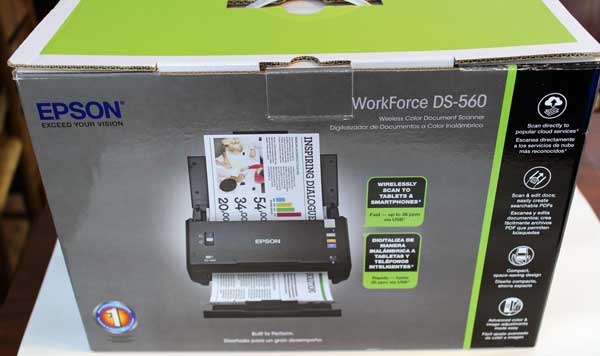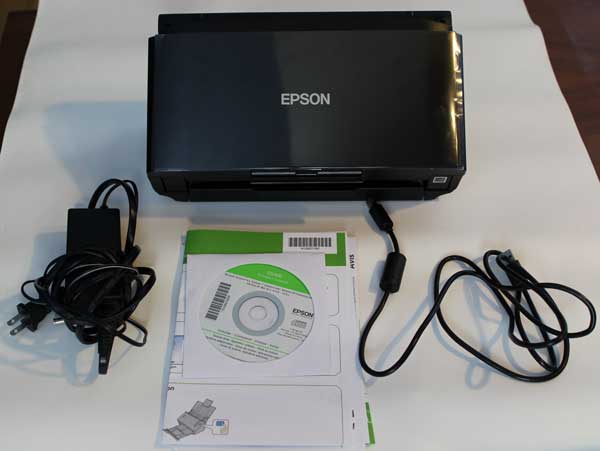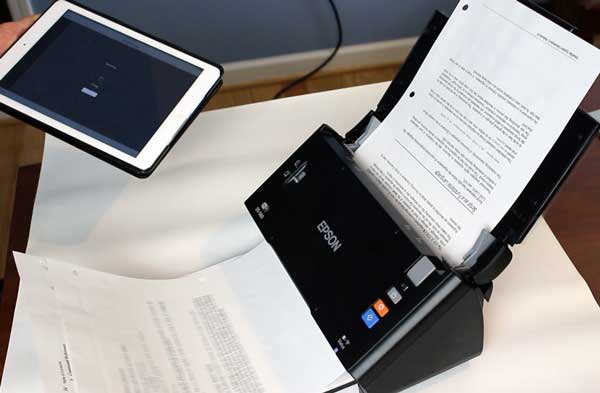Scanning stacks of nasty paper documents into digital form has never been easier, so today I want to take a look at the Epson WorkForce DS-560 Document Scanner to see if it’s up to the job.
This scanner is said to scan wirelessly to mobile devices, and at speeds up to 26 pages per minute via USB. The scanner also can send documents to cloud services such as Evernote and Google Drive. And, the scanner is said to have a small footprint on your desk along with options for making color and image adjustments to scanned documents.
In the box you get the scanner itself, a power cable, a USB 2.0 cable to connect the scanner to your computer, a Start Here document, and a CD with software and manual.
There are a number of features in this scanner:
- It comes with a 50-page automatic document feeder that works well–there are multiple rows of rollers that help feed the documents smoothly and quickly.
- When attached to a computer via USB, the scanner scans up to 26 pages per minute.
- Once a document is scanned, you can save the pdf to your computer, email it to someone, or send it to the Internet via FTP, web folder, or to a cloud service like Evernote or Google Drive. In particular, the sending-the-doc-to-Evernote feature worked much better than on another scanner I used that demanded I give to its software the login credentials to my Evernote account before it would sync with it. I like Epson’s way of syncing better, since with Epson I didn’t have to give my login credentials to a third party application.
- You can remotely scan via attaching to the scanner’s WiFi access point with your computer or with your mobile device and free Epson scanner app.
- You can remotely scan via attaching the scanner to your home or office’s WiFi network.
- You can scan a document that’s too large to fit into the document feeder by folding the document in half.
- You can create different scanning profiles for different types of scanning projects you might have–image resolution, single-vs-double-sided, etc.–and then you can assign a profile you want to use to the scan button.
Though the above features are very nice, not everything worked out well in my testing of this Epson scanner.
You are also supposed to be able to put the scanner onto your home or office network. However, the steps to do this were very complicated and involved switching between multiple not-user-friendly Epson utilities. I was using OS X (Macbook Air) and the Apple Airport Extreme, which does not have WPS (WiFi Protected Setup). Unfortunately, in the end, I was never able to successfully get the scanner onto my wireless network.
[ UPDATE: I kept trying and trying, and finally succeeded in getting this scanner onto my network! So the technology is there in the scanner, it is just really painful to set up. My final thoughts about the scanner however stand. ]
I found this to be a competent, even powerful scanner, when using it hooked directly to my computer via USB. It has some cool features, scans quickly, and allows me to send the documents where I want. Also, I liked the ability to scan directly to my iPad or Android device.
But its wireless features seem to be its weak point–remote scanning handicapped by a poor setup process and poor documentation. It’s a mystery to me why the development department at Epson made setting up WiFi so difficult on a scanner where it’s main feature is WiFi scanning. Why don’t they just add a webpage on the device’s web server that allows you to enter your WiFi credentials? This would be operating system independent–any browser, tablet, laptop, desktop, or chrome book could setup the unit. Anyway, if WiFi is not important to you, then you might save some money by buying the non-wireless version of this scanner, the Epson DS-510.
So, that’s it for now–I hope this review has been helpful!
Pricing and Availability: Epson WorkForce DS-560 Document Scanner


